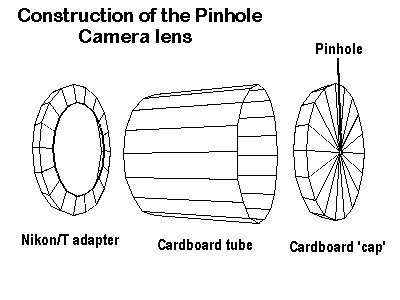Pinhole Photographs |
Story location: Home / photography / pinhole / |
| 18/Jan/2005 |
The images here were taken with my two pinhole cameras: the pinhole modified Lubitel medium format camera and the Nikon FM pinhole 'lens'. The increased film size of the Lubitel gives better resolution than the 35mm pinhole camera.












Click on the thumbnail to view the image
Making a Pinhole Camera |
Story location: Home / photography / pinhole / |
| 18/Jan/2005 |
After reading an article on the web about pinhole cameras, I decided to make my own pinhole lens to fit on my Nikon FM. I had a look at some articles on the internet for inspiration, but most of these concentrated on building entire pinhole cameras. I already had a perfectly serviceable camera so I decided the best course of action would be to simply make a pinhole lens for it.
 Making the lens would be fairly easy - this was simply a disc of cardboard with a hole cut in the middle. I then sellotaped foil across the hole, and made a smaller hole in the foil with a pin. The only remaining problem would be attaching the lens to the camera. I realised that the t-mount that I use for astrophotography could be attached to the camera, and the lens could then be attached to the mount.
Making the lens would be fairly easy - this was simply a disc of cardboard with a hole cut in the middle. I then sellotaped foil across the hole, and made a smaller hole in the foil with a pin. The only remaining problem would be attaching the lens to the camera. I realised that the t-mount that I use for astrophotography could be attached to the camera, and the lens could then be attached to the mount.
The focal length of the lens can be adjusted by using a different length of cardboard tube - the actual focal length being the distance from the pinhole to the image plane. The lens as shown in the diagram had a focal length of 100mm and an aperture of approximately f/100 (the actual aperture was measured using a magnifying glass and a ruler.

Metering the exposure can be tricky with such a small aperture. Most cameras will allow TTL metering with such a lens, but an aperture of f100 may be too slow for accurate results. The Nikon FM is only suitable in bright conditions because the shutter speed doesn't go below 1 second - slower speeds need the B setting. The Nikon F70 is ideal for this purpose. Selecting aperture priority auto exposure, and covering the eyepiece (to stop stray light affecting the metering), reasonably accurate exposures may be obtained. The camera thinks a manual focus lens is attached, with the aperture fully open, and meters accordingly. Reciprocity failure will rear its head for exposures over 1 second, but with negative film this shouldn't present much of a problem with 'shortish' exposures of about 5 seconds.
If TTL metering is not available - which may be the case for some autofocus cameras (such as the Nikon F50) then a separate hand held meter can be used. If you are lucky enough to own one which goes down to f100 then a straightforward meter reading may be taken. If, like me, your meter only goes down to f22, then a reading can be taken at that setting, and a correction factor applied to the shutter speed. In this case, f100 is just over 4 stops less than f22 (following the sequence f22,32,45,64,90 etc), so I divided the shutter speed by 4 e.g. a reading of ¼s at f22 is just over 1 second at f100.
Recently, I have moved up to medium format for my pinhole work. This was done using a simple modification to an old Lubitel camera. I took it apart and removed the lens! The lens quality wasn't very good, and as I recently bought a second hand Yashicamat, I no longer needed the Lubitel (it had actually been sitting in the back of a cupboard for several years, gathering dust).
Removing the lens was remarkably easy. It was a simple triplet, with the elements held in place using clips. I placed a foil pinhole at the front of the camera, and set the shutter speed to B. The aperture was about f/160. View the pinhole photos
